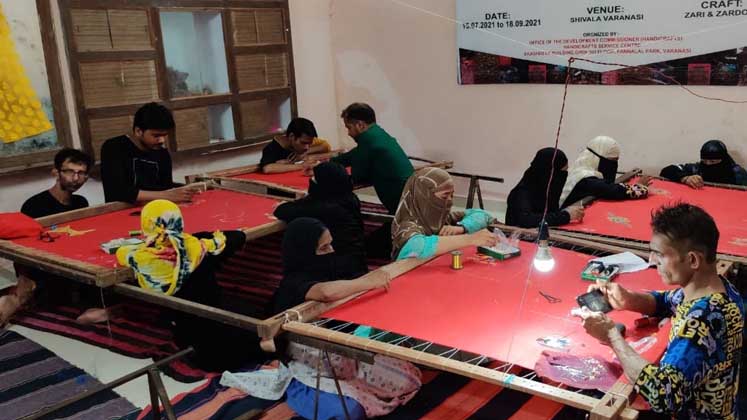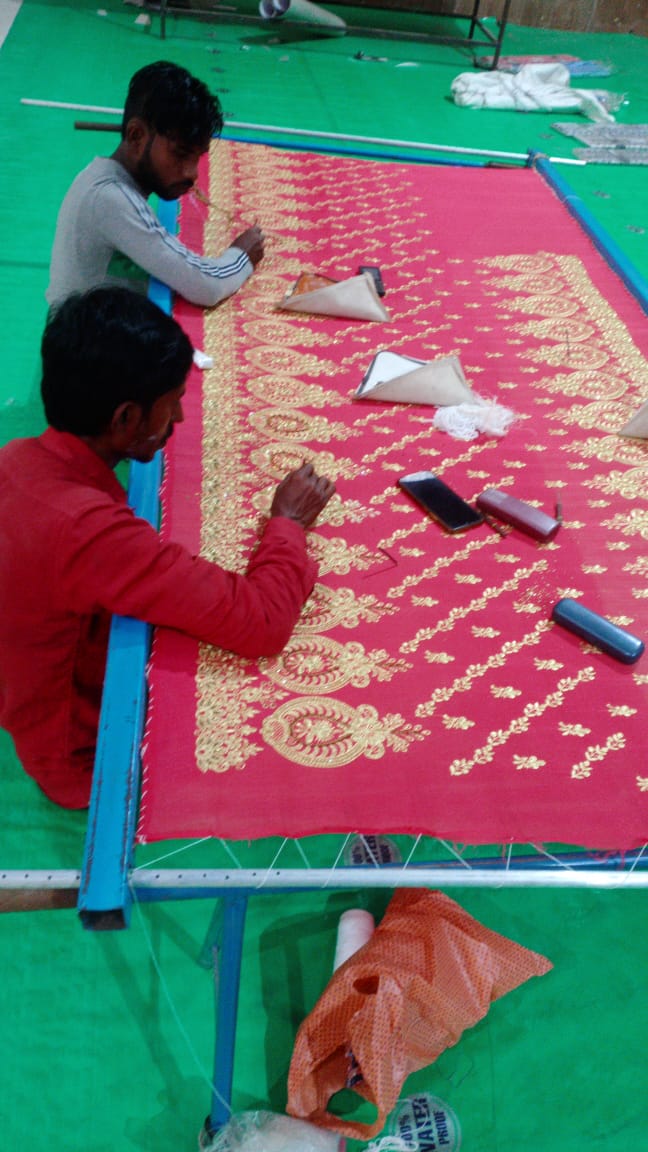 As per industry estimates, India has around 12.48 million women homeworkers in the non-agricultural sector. Out of this, nearly 16 per cent women are involved in apparel and 11 per cent are associated with textiles related work (a total of 3.36 million). These workers are most vulnerable stakeholders in the supply chain as they have least (almost nil) economic and social security. Time to time, various brands and civil society organisations take initiatives for these workers but despite all this, their condition has not improved much. A recent report, Homeworkers in garment supply chains: Research from India and Nepal by HomeNet South Asia Trust (HNSA) also highlights this fact.
As per industry estimates, India has around 12.48 million women homeworkers in the non-agricultural sector. Out of this, nearly 16 per cent women are involved in apparel and 11 per cent are associated with textiles related work (a total of 3.36 million). These workers are most vulnerable stakeholders in the supply chain as they have least (almost nil) economic and social security. Time to time, various brands and civil society organisations take initiatives for these workers but despite all this, their condition has not improved much. A recent report, Homeworkers in garment supply chains: Research from India and Nepal by HomeNet South Asia Trust (HNSA) also highlights this fact.
As Covid has impacted every segment of the textile industry badly, it is high time to focus on these workers also as their traditional hand work has carved a niche for India in the global market in the domain of highly value-added garments. Average monthly earning of these workers in established apparel manufacturing hubs like Delhi as well as Tirupur is very low as compared to the country’s or states’ monthly minimum wage. A time and motion study will therefore be helpful to determine the value of money for the type of work.
Homeworkers work from their homes or adjacent premises other than those of the workplace of an employer. They are sub-contracted workers found in the lower tiers of the global supply chains. The major source of work for homeworkers come from these sub-contractors/ agents. These workers work on piece-rate basis. Delhi-NCR, Tirupur, Bareilly and some cities of western Uttar Pradesh, Lucknow and nearby areas, Narsapur (Andhra Pradesh), Jaipur and allied areas are good hubs for homeworkers. Overall there are many small and big cities where lot of homeworkers are involved in various kind of work of textile and apparel industry.
Skills and the type of craft
In Delhi, embellishment and embroidery are the most common type of work for homeworkers while in Tirupur, their work consists of cropping, trimming, labelling, folding and embellishment. Though these workers are known for their traditional craft/needle work but depending upon the region and working of hubs, stitching, crochet, finishing/quality controlling/checking, cutting, ironing, folding and knitting are some of the other work homeworkers also perform.
Type of work, quantity, extra time needed to rectify damaged pieces, household environment and housing condition that directly impact the output of the homeworkers affects their piece rate earnings. That’s why difficulties in determining piece rates become one of the biggest challenges for the growth of homeworkers.
The survey conducted by HNSA on 614 women homeworkers particularly concentrated in Delhi and Tirupur between January and March 2020 reflects the pre-Covid situation.
Majority of the homeworkers (72 per cent in Tirupur and 65 per cent in Delhi) were found not to be involved in any proper and systematic training. Association/NGOs working for these workers conducted some sessions covering development trainings, training on occupational health and safety, rights based training, and it was observed that financial literacy of the women taking these trainings was very low.
Also Read: Homeworkers need to get involved with new tools
Working condition and allied issues
As per the survey, homeworkers earn per month an average of Rs. 2,183 (US $ 30) in Tirupur and Rs. 2,165 in Delhi. When there is work, most of the homeworkers work fewer than 8 hours per day. In Tirupur 67 per cent workers work for less than 15 days in a month while in Delhi, the same is about 15-20 days every month.
Besides, there is almost nil social security benefits for these homeworkers provided by employers. While organised homeworkers working in the supply chains enjoy some benefits, they are deprived of employee-employer agreements, minimum wages and social security.
As far as accessibility to basic services is concerned, conditions in Tirupur are worrisome as only 5.8 per cent workers have personal toilet and 0.5 per cent have housing. Though the survey showed that accessibility to basic services was quite high in Delhi, SEWA Bharat mentioned that infrastructure of these facilities existed, but they were poorly maintained and managed.
In Delhi, 93 per cent workers work inside their house, while in Tirupur, 32 per cent work in their home while rest work in nearby street/ community centre. They are also likely to be exposed to fibre dust. Most common health issues faced by these workers are eye strain or headache and back pain (66 per cent and 43 per cent in Delhi), cuts and wounds from needle/ thread (30 per cent), and neck/shoulder pain (28 per cent). Most of them use over-the-counter medicine to deal with their health issues.
In Delhi, the homeworkers hardly receive any proper vaccination and they barely use safety equipment like needle guards, hand gloves, masks and apron.
On the work front too, the sufferings of these workers don’t seem to subside. Majority of them end up having verbal agreements with the contractors or agents and even when there is a verbal agreement, contractors or agents frequently change the piece rates or deadlines afterwards, as large work orders could take anything from a few days to up to weeks or even months. Lack of proper agreement allows contractors or agents to alter their piece rates once orders are completed by homeworkers. Having no written agreement renders the homeworkers to remain hidden and out of the view of their primary employers and the brands they work for.
On the other hand, there are some positive steps also in line in Tirupur where many homeworkers are able to track their orders by keeping passbook signed by the contractors.
In Delhi, workers receive payment once a month, while the majority of homeworkers in Tirupur are paid once a week. The good thing is that only 1.9 per cent workers in Delhi and 0.8 per cent in Tirupur complain about payment delay. 2.8 per cent and 7.3 per cent workers in both the places respectively have complained about verbal abuse/insult.
In Delhi, the majority of homeworkers are not interested in negotiating due to high competition and the fear of losing the only work they have. In Tirupur too, the homeworkers mostly are not involved in any negotiations. Sometimes they end up not getting enough work due to high competition and at times, family commitments also play a major factor in lessening the number of working days.
Out of those who conduct negotiations to increase the piece rates, more than half of the homeworkers (55 per cent) in Delhi report that negotiations do not help to increase their piece rates, while another 43 per cent mention that such discussions help slightly. In Tirupur, as high as 81 per cent said that negotiations are of little help while another 19 per cent admitted it has helped a lot.
It is pertinent to mention here that the above conditions are despite the fact that in Delhi, 100 per cent homeworkers are from urban areas while in Tirupur, the respondents come from both semi-urban (69 per cent) and urban (31 per cent) areas.
The good aspect is that a majority of homeworkers in Delhi as well as Tirupur do not experience any form of misbehaviour from the contractors or the persons who provide work. Similarly when work orders are not up to the mark, they are asked to rework and rectify the pieces but get full payment.
Organisations supporting homeworkers
In Delhi, SEWA Bharat has had a presence since 2010 and has been organising homeworkers since then. Its sister organisation, Ruaab, has conducted many rights-based awareness training for women living in different communities; this has generated more awareness among them. In Tirupur, through the intervention of Social Awareness and Voluntary Association (SAVE), homeworkers are the members of self–help groups (SHGs) where they support each other.
Steps needed to be taken immediately
Looking at all the above challenges of homeworkers, efforts need to increase manifold, especially towards organising homeworkers in garment supply chains. There is a strong need to ramp up their capacity building efforts towards educating homeworkers in technical subjects such as the importance of transparency, dynamics of apparel supply chains. Most urgent issues include calculating piece-rate wages based on minimum wage, the importance of solidarity and collective voice, awareness on occupation safety and health in the workplace (even when the workplace is the home) and rights to basic services.
The survey indicates that suppliers and buyers need to acknowledge that they have homeworkers in their supply chain and recognise them as workers with equal rights, developing policies and systems that affirm this. Apparel manufacturing companies need to work with their subcontractors to ensure that they are mapped and registered and that their working conditions are consistent with national and international labour standards.
Buyers need to be accountable for the conditions of homeworkers and ensure that labour and human rights are adhered to. They also need to provide decent work to homeworkers, which includes minimum wages and access to social security as the bare minimum.







